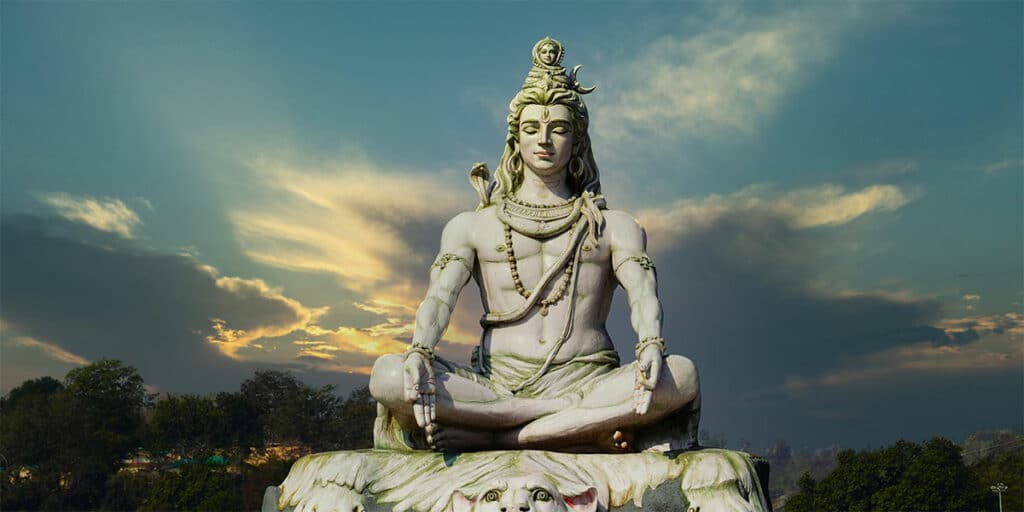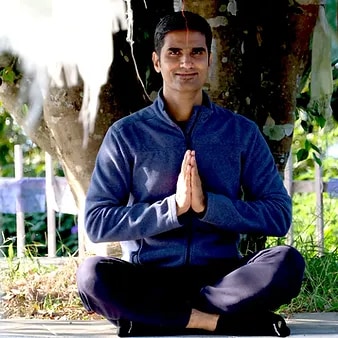Mahashivratri: The Union of Yoga and Devotion
by Hardik Mehta

Mahashivratri, the great night of Lord Shiva, holds profound significance in Hindu culture and spirituality. It is a time of deep introspection, devotion, and spiritual awakening. In the practice of yoga, Mahashivratri represents an opportunity to delve deeper into the union of the individual soul with the universal consciousness. In this blog, we will explore the significance of Mahashivratri in the context of yoga, its rituals, practices, and the transformative potential it holds for practitioners on their spiritual journey.
The Significance of Mahashivratri
Mahashivratri, celebrated on the 14th day of the dark fortnight in the Hindu month of Phalgun, holds great significance in Hindu mythology. It is believed to be the night when Lord Shiva performs the cosmic dance of creation, preservation, and destruction. Devotees observe fasting, perform rituals, and offer prayers to Lord Shiva to seek his blessings for spiritual growth, inner peace, and liberation from the cycle of birth and death.
Mahashivratri and Yoga: A Union of Consciousness
In the practice of yoga, Mahashivratri symbolizes the union of individual consciousness (Atman) with the universal consciousness (Brahman). It represents an opportunity for practitioners to deepen their sadhana (spiritual practice), cultivate devotion, and awaken the dormant energies within. Through asana, pranayama, meditation, and self-inquiry, practitioners harness the energy of Mahashivratri to transcend the limitations of the ego and merge with the divine. Mahashivratri is also a time for Bhakti Yoga, the path of devotion. Devotees chant sacred mantras, sing bhajans (devotional songs), and offer prayers to Lord Shiva with utmost reverence and devotion. This devotional practice creates a heart-cantered connection with the divine, leading to a deep sense of surrender and unity.
Moreover, Mahashivratri serves as a reminder of the symbolism of Lord Shiva in yoga philosophy. As the embodiment of detachment, self-realization, and compassion, Lord Shiva inspires practitioners to transcend duality, awaken higher consciousness, and realize the unity of all beings.
In essence, Mahashivratri and yoga converge to create a sacred space for practitioners to explore the depths of their being, cultivate devotion, and merge with the universal consciousness. It is a time of inner reflection, purification, and spiritual elevation, offering practitioners a glimpse into the timeless wisdom and boundless potential of the yogic path.
Rituals and Practices on Mahashivratri
On Mahashivratri, devotees engage in various rituals and practices to honor Lord Shiva and invoke his grace. Fasting is a common practice, symbolizing purification of the body and mind. Many devotees also observe Jagran (night-long vigil), chanting mantras, singing bhajans, and performing Abhishekam (ritual bathing) of Shiva Lingam with milk, water, honey, and other sacred substances. These rituals are believed to purify the consciousness and create conducive conditions for spiritual elevation.
The Role of Yoga in Mahashivratri Celebrations
Yoga plays a central role in Mahashivratri celebrations, offering practitioners a powerful means to connect with the divine within. Through the practice of Hatha Yoga, practitioners purify the physical body and balance the energy channels (nadis) to prepare for deeper states of meditation. Kundalini Yoga harnesses the latent energy at the base of the spine (Kundalini Shakti) and awakens it through specific practices such as Pranayama, Bandhas, and Mudras. Bhakti Yoga, the path of devotion, involves chanting sacred mantras, singing devotional songs, and offering heartfelt prayers to Lord Shiva as a form of surrender and love.
The Symbolism of Lord Shiva in Yoga
Lord Shiva, the quintessential yogi, embodies the highest ideals of yoga – detachment, self-realization, and compassion. His iconic form as Nataraja (the cosmic dancer) represents the eternal rhythm of creation and destruction, symbolizing the impermanence of life and the cyclical nature of existence. The third eye of Lord Shiva signifies the awakening of higher consciousness, transcending duality and realizing the unity of all beings.
Mahashivratri: A Time for Inner Transformation
Mahashivratri, celebrated with fervour and devotion, transcends mere ritualistic observance to become a profound opportunity for inner transformation. This sacred night, dedicated to Lord Shiva, invites individuals to delve deep into the recesses of their beings, shedding layers of ego and illusion to reveal the essence of their true selves. Through fasting, prayer, and meditation, practitioners purify the body, mind, and spirit, creating fertile ground for spiritual growth and awakening. Mahashivratri symbolizes the triumph of light over darkness, of consciousness over ignorance, and serves as a potent reminder of the eternal dance of creation and destruction within and without. As we immerse ourselves in the auspicious energy of Mahashivratri, let us embrace the opportunity for inner reflection, self-inquiry, and transformation, harnessing the divine grace of Lord Shiva to illuminate our path towards self-realization and ultimate liberation.
The Reverberations of Mahashivratri Beyond the Night
The blessings of Mahashivratri extend far beyond the night of celebration. As practitioners deepen their commitment to yoga and self-discovery, they carry the transformative energy of Mahashivratri with them throughout the year. The insights gained, the practices cultivated, and the devotion kindled on this auspicious occasion serve as guiding lights on the path of yoga, illuminating the way towards greater clarity, joy, and liberation.
On Mahashivratri, chanting mantras dedicated to Lord Shiva can enhance the spiritual atmosphere and deepen one’s connection with the divine. Here are some powerful mantras to chant on Mahashivratri:
Om Namah Shivaya: This is one of the most widely known and revered mantras dedicated to Lord Shiva. It translates to “I bow to Shiva” and invokes the presence and blessings of Lord Shiva.
Mahamrityunjaya Mantra: Also known as the Maha Mrityunjaya Mantra, it is a powerful mantra for healing, protection, and liberation from the cycle of birth and death. It is believed to bestow longevity and spiritual rejuvenation.
Mantra: “Om Tryambakam Yajamahe, Sugandhim Pushtivardhanam, Urvarukamiva Bandhanan, Mrityor Mukshiya Maamritat” (ॐ त्र्यम्बकं यजामहे, सुगन्धिं पुष्टिवर्धनं, उर्वारुकमिव बन्धनान्, मृत्योर्मुक्षीय मामृतात्)
Shiva Gayatri Mantra: This mantra is a powerful invocation of Lord Shiva’s energy and wisdom. It is chanted to seek blessings for spiritual growth, knowledge, and enlightenment.
Mantra: “Om Tatpurushaya Vidmahe, Mahadevaya Dhimahi, Tanno Rudrah Prachodayat” (ॐ तत्पुरुषाय विद्महे, महादेवाय धीमहि, तन्नो रुद्रः प्रचोदयात्)
Shiva Panchakshara Mantra: Also known as the Panchakshara Mantra, it consists of five syllables – “Namah Shivaya.” Chanting this mantra with devotion can purify the mind, remove obstacles, and lead to spiritual liberation.
Mantra: “Om Namah Shivaya” (ॐ नमः शिवाय)
Shiva Dhyan Mantra: This mantra is chanted to invoke the divine presence of Lord Shiva and aid in deep meditation and contemplation.
Mantra: “Karpoora Gauram Karunavataram, Sansara Saram Bhujagendra Haram, Sada Vasantam Hridayaravinde, Bhavam Bhavani Sahitam Namami” (कर्पूरगौरं करुणावतारम्, संसारसारं भुजगेन्द्रहारम्, सदा वसन्तं हृदयारविन्दे, भवं भवानि सहितं नमामि)
Chanting these mantras with sincerity, devotion, and understanding of their meanings can amplify the spiritual energy of Mahashivratri and lead to profound inner transformation.
Embracing the Essence of Mahashivratri Through Yoga
In conclusion, Mahashivratri represents the convergence of yoga and devotion, offering practitioners a sacred gateway to higher states of consciousness and inner union with the divine. By immersing oneself in the practices of yoga, meditation, and devotion, practitioners awaken to the timeless wisdom of Lord Shiva and the boundless potential of the human spirit. As we celebrate Mahashivratri, let us embrace the essence of this auspicious occasion with reverence, devotion, and a deep commitment to the path of yoga and self-realization.
Sayujya Yoga offers 200 Hours TTC and is one of the best yoga institutes in Mumbai, offering Yin Yan Yoga, Ashtanga Vinyasa Course, and more.
We guide our students to cultivate a deep reverence for yoga as a path to holistic well-being and spiritual evolution.
About the Author

Hardik Mehta
Hardik is an E-RYT 500 & YACEP (Yoga Alliance Continuing Education Provider), Yoga Alliance, USA. He has been practicing yoga for the last 9 years. Prior to finding his true calling in Yoga, he was working with various corporates for 12 years in the Retail and eCommerce sector.
